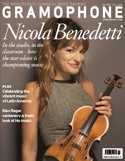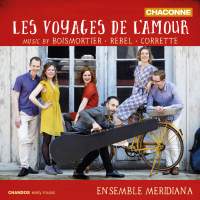Texte paru dans: / Appeared in: |
|
|
Outil de traduction (Très approximatif) |
|
|
Reviewer: Julie Anne Sadie
‘Les voyages de l’Amour’ takes its name from a 1736 opéra-ballet by Boismortier. Looking at the instrumentation for that work, one might assume that twice as many players might be required to perform it, but instead, nearly all the members of Ensemble Meridiana put down and pick up a second or third instrument in the course of the opening Simphonie, which is a succession of contrasting sections, each differently orchestrated. In short, quite a tour de force.
The rest of the disc is devoted to ballet music, sonatas and concertos by Boismortier, Rebel and Corrette dating from the last years of the reign of Louis XIV and the early years of Louis XV. As in the first Boismortier item, Ensemble Meridiana vary the instrumentation from movement to movement, except in Rebel’s sonata (1713), which is specifically composed for violin, bass viol and continuo. Less successful is the 1726 Boismortier Sonata (from Op 14), specifically intended for a pair of bass instruments, be they bassoons, viols or cellos; faute de mieux Ensemble Meridiana have unwisely paired unlike instruments – a bassoon and bass viol – which produces an unbalanced texture.
Among their arsenal of instruments are, however, some intriguing and delightful surprises. In the closing ‘Mouvement de Chaconne’ of Boismortier’s Premier Ballet de Village (1734) the colascione – a novelty instrument resembling a small, longnecked lute played with a plectrum – can be clearly heard enriching the Baroque guitar as part of the continuo forces. Less immediately identified is the sound of quinton (aka a pardessus) in that work (listen to track 8 for the clearest evidence) and the voice flute (recorder) in Rebel’s Les caractères de la danse (1715).
The overall
impression of this music, and Corrette’s Concerto comique (1733) in
particular, is consistent with lighthearted occasions such as the autumn and
spring Paris fairs with which Corrette was associated, contributing to a richer
impression of the wider French 18th-century soundscape. |
|
|
Consultez d'autres mois / Browse other months
|
|
|
|
|
|
Cliquez l'un ou l'autre
bouton pour découvrir bien d'autres critiques de CD |
|




